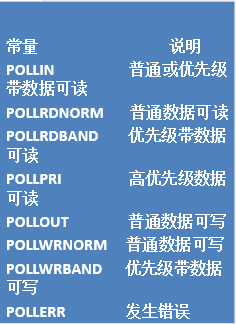概念
poll机制引入前,我们来先来说下I/O复用,所谓I/O复用就是解决能够同时操作多个设备的方法,及时处理多个设备的数据,I/O复用的方法大概有如下,应用程序使用poll,select系统调用,应用程序使用多线程技术,比如处理按键一个线程,处理鼠标一个线程,由于线程是并行运行,所有可以同时处理按键和鼠标,工作机制如下,poll和select的机制道理是一样的,监听文件描述符集,当没有文件可以读写则挂入等待队列睡眠,当有一个或多个fd发生变化的,则从阻塞状态返回,转而处理该文件描述符IO操作,poll函数比select函数更强大的功能,更细粒的等待时间

函数介绍

poll()接受一个指向结构"struct pollfd"列表的指针,其中包括了你想测试的文件描述符和事件,事件由一个在结构中事件域的比特掩码确定
struct pollfd
{
int fd; //文件描述符
short event;//等待的需要测试事件
short revents //实际发生了的事件
};
events和revents的值见表

内核源码分析
所有的系统调用,基于都可以在它的名字前加上“sys_”前缀,这就是它在内核中对应的函数.比如系统调用open,rea,write,poll,与之对应的内核函数为:sys_open,sys_read,sys_write,sys_poll.
1.
sys_poll函数位于fs/select.c文件中,代码如下:
asmlinkage long sys_poll(struct pollfd __user *ufds, unsigned int nfds,
long timeout_msecs)
{
s64 timeout_jiffies;
if (timeout_msecs > 0) {
#if HZ > 1000
/* We can only overflow if HZ > 1000 */
if (timeout_msecs / 1000 > (s64)0x7fffffffffffffffULL / (s64)HZ)
timeout_jiffies = -1;
else
#endif
timeout_jiffies = msecs_to_jiffies(timeout_msecs);
} else {
/* Infinite (< 0) or no (0) timeout */
timeout_jiffies = timeout_msecs;
}
return do_sys_poll(ufds, nfds, &timeout_jiffies);
}
上述的代码对超时参数稍作处理后,直接调用do_sys_poll
2.
do_sys_poll函数也位于位于fs/select.c文件中,我们取出主要部分的代码:
int do_sys_poll(struct pollfd __user *ufds, unsigned int nfds, s64 *timeout)
{
……
struct poll_wqueues table;
poll_initwait(&table);
……
fdcount = do_poll(nfds, head, &table, timeout);
……
}
poll_initwait函数非常简单,它初始化一个poll_wqueues变量table,table->pt->qproc = __pollwait,从__pollwait的代码可知,它只是把当前进程挂入我们驱动程序里定义的一个队列里而已,__pollwait将在驱动的poll函数里用到,进而调用do_poll函数。
3.do_poll函数位于fs/select.c文件中,代码如下:
static int do_poll(unsigned int nfds, struct poll_list *list,
struct poll_wqueues *wait, s64 *timeout)
{
int count = 0;
poll_table* pt = &wait->pt;
/* Optimise the no-wait case */
if (!(*timeout))
pt = NULL;
for (;;) {
struct poll_list *walk;
long __timeout;
set_current_state(TASK_INTERRUPTIBLE);
for (walk = list; walk != NULL; walk = walk->next) {
struct pollfd * pfd, * pfd_end;
pfd = walk->entries;
pfd_end = pfd + walk->len;
for (; pfd != pfd_end; pfd++) {
/*
* Fish for events. If we found one, record it
* and kill the poll_table, so we don't
* needlessly register any other waiters after
* this. They'll get immediately deregistered
* when we break out and return.
*/
if (do_pollfd(pfd, pt)) {
count++;
pt = NULL;
}
}
}
/*
* All waiters have already been registered, so don't provide
* a poll_table to them on the next loop iteration.
*/
pt = NULL;
if (count || !*timeout || signal_pending(current))
break;
count = wait->error;
if (count)
break;
if (*timeout < 0) {
/* Wait indefinitely */
__timeout = MAX_SCHEDULE_TIMEOUT;
} else if (unlikely(*timeout >= (s64)MAX_SCHEDULE_TIMEOUT-1)) {
/*
* Wait for longer than MAX_SCHEDULE_TIMEOUT. Do it in
* a loop
*/
__timeout = MAX_SCHEDULE_TIMEOUT - 1;
*timeout -= __timeout;
} else {
__timeout = *timeout;
*timeout = 0;
}
__timeout = schedule_timeout(__timeout);
if (*timeout >= 0)
*timeout += __timeout;
}
__set_current_state(TASK_RUNNING);
return count;
}
*if (count || !timeout || signal_pending(current))可以看出当count非0,超时,有信号等待处理结束循环,count非0表示do_pollfd至少有一个成功,__timeout = schedule_timeout(__timeout)使进程进入休眠状态一段时间,除了休眠到指定时间被系统唤醒外,还可以被驱动程序唤醒,这就是为什么驱动的poll里要调用poll_wait的原因,后面分析。
4.do_pollfd函数位于fs/select.c文件中,代码如下:
static inline unsigned int do_pollfd(struct pollfd *pollfd, poll_table *pwait)
{
……
if (file->f_op && file->f_op->poll)
mask = file->f_op->poll(file, pwait);
……
}
可见,它就是调用我们的驱动程序里注册的poll函数。
驱动程序设计
驱动程序里与poll相关的地方有两处:1.是构造file_operation结构时,要定义自己的poll函数2.是通过poll_wait来调用上面说到的__pollwait函数,pollwait的代码如下:
static inline void poll_wait(struct file * filp, wait_queue_head_t * wait_address, poll_table *p)
{
if (p && wait_address)
p->qproc(filp, wait_address, p);
}
p->qproc就是__pollwait函数,从它的代码可知,它只是把当前进程挂入我们驱动程序里定义的一个队列里而已。它的代码如下:
static void __pollwait(struct file *filp, wait_queue_head_t *wait_address,
poll_table *p)
{
struct poll_table_entry *entry = poll_get_entry(p);
if (!entry)
return;
get_file(filp);
entry->filp = filp;
entry->wait_address = wait_address;
init_waitqueue_entry(&entry->wait, current);
add_wait_queue(wait_address, &entry->wait);
}
内核程序设计时我们在fops写我们的poll函数时,我们会调用poll_wait函数(这里调用的是回调函数__pollwait,刚函数在do_sys_poll阶段被注册,可见,poll_wait的作用,只是为了让驱动程序能找到要唤醒的进程)把进程放入等待队列,进程并没有休眠,我们的驱动程序里实现的poll函数是不会引起休眠的.让进程进入休眠,是前面分析的do_sys_poll函数的“__timeout = schedule_timeout(__timeout)”,进入睡眠后如果我们的驱动程序发现情况就绪,可以把这个队列上挂着的进程唤醒
现在来总结一下poll机制:
-
poll > sys_poll > do_sys_poll > poll_initwait,poll_initwait函数注册一下回调函数__pollwait,它就是我们的驱动程序执行poll_wait时,真正被调用的函数。
-
接下来执行file->f_op->poll,即我们驱动程序里自己实现的poll函数 它会调用poll_wait把自己挂入某个队列,这个队列也是我们的驱动自己定义的;它还判断一下设备是否就绪。
-
如果设备未就绪,do_sys_poll里会让进程休眠一定时间
-
进程被唤醒的条件有2:一是上面说的“一定时间”到了,二是被驱动程序唤醒.驱动程序发现条件就绪时,就把“某个队列”上挂着的进程唤醒,这个队列,就是前面通过poll_wait把本进程挂过去的队列。
-
如果驱动程序没有去唤醒进程,那么shedule_timeout(__timeou)超时后,会重复2,3动作,直到应用程序的poll调用传入的时间到达。
流程图:


driver.c
#include <linux/module.h>
#include <linux/kernel.h>
#include <linux/fs.h>
#include <linux/init.h>
#include <linux/delay.h>
#include <asm/uaccess.h>
#include <asm-arm/irq.h>
#include <linux/irq.h>
#include <asm/io.h>
#include <asm-arm/arch-s3c2410/gpio.h>
#include <asm/arch/regs-gpio.h>
#include <asm/hardware.h>
#include <linux/cdev.h>
#include <linux/device.h>
#include <linux/interrupt.h>
#include <linux/poll.h>
int chr_major;
struct cdev cgs_dev;
static struct class *led_class;
static struct class_device *led_class_dev;
volatile unsigned long *gpfcon = NULL;
volatile unsigned long *gpfdat = NULL;
DECLARE_WAIT_QUEUE_HEAD(button_queue);
static volatile int ev_press = 0;
static unsigned char value;
struct pin_desc
{
char *name;
unsigned int pin;
unsigned int irq;
unsigned int key_val;
};
static struct pin_desc pd[4] =
{
{"S1",S3C2410_GPF0,0,0x01},
{"S2",S3C2410_GPF2,0,0x02},
{"S3",S3C2410_GPG3,0,0x03},
{"S4",S3C2410_GPG11,0,0x04},
};
static irqreturn_t buttons_handler(int irq,void *dev_id)
{
struct pin_desc *desc = (struct pin_desc*)dev_id;
if(strcmp("S1",desc->name)==0)
{
value = desc->key_val;
*gpfdat &= ~(1<<6);
ev_press = 1; /* 表示中断发生了 */
wake_up_interruptible(&button_queue); /* 唤醒休眠的进程 */
}
if(strcmp("S2",desc->name)==0)
{
value = desc->key_val;
*gpfdat &= ~(1<<5);
ev_press = 1; /* 表示中断发生了 */
wake_up_interruptible(&button_queue); /* 唤醒休眠的进程 */
}
if(strcmp("S3",desc->name)==0)
{
value = desc->key_val;
*gpfdat &= ~(1<<4);
ev_press = 1; /* 表示中断发生了 */
wake_up_interruptible(&button_queue); /* 唤醒休眠的进程 */
}
if(strcmp("S4",desc->name)==0)
{
value = 0x88;
*gpfdat &= ~((1<<4) | (1<<5) | (1<<6));
ev_press = 1; /* 表示中断发生了 */
wake_up_interruptible(&button_queue); /* 唤醒休眠的进程 */
}
return IRQ_RETVAL(IRQ_HANDLED);
}
static int cgs_led_open (struct inode *inode, struct file *file)
{
int i;
*gpfcon &= ~((0x3<<(4*2)) | (0x3<<(5*2)) | (0x3<<(6*2)));
*gpfcon |= ((0x1<<(4*2)) | (0x1<<(5*2)) | (0x1<<(6*2)));
for(i=0;i<4;i++)
{
pd[i].irq = gpio_to_irq(pd[i].pin);
request_irq(pd[i].irq,buttons_handler, IRQT_BOTHEDGE,pd[i].name,&pd[i]);
}
return 0;
}
ssize_t cgs_led_read (struct file *file, char __user *buf, size_t size, loff_t *ppos)
{
if (size != 1)
return -EINVAL;
wait_event_interruptible(button_queue, ev_press);
copy_to_user(buf,&value,1);
ev_press = 0;
return 1;
}
static unsigned cgs_led_poll(struct file *file, poll_table *wait)
{
unsigned int mask = 0;
poll_wait(file,&button_queue,wait);
if(ev_press)
mask |= POLLIN|POLLRDNORM;
return mask;
}
struct file_operations cgs_fops ={
.owner = THIS_MODULE,
.open = cgs_led_open,
.read = cgs_led_read,
.poll = cgs_led_poll,
};
static int __init cgs_lcd_init(void)
{
dev_t dev;
int result;
cgs_dev.owner = THIS_MODULE;
result = alloc_chrdev_region(&dev,0, 1,"cgs_led");
if(result<0)
{
return result;
}
chr_major = MAJOR(dev);
cdev_init(&cgs_dev,&cgs_fops);
cdev_add(&cgs_dev,MKDEV(chr_major,0),1);
led_class = class_create(THIS_MODULE,"cgs_led");
led_class_dev = class_device_create(led_class,NULL,MKDEV(chr_major,0),NULL,"cgs_led");
gpfcon = (volatile unsigned long*)ioremap(0x56000050,16);
gpfdat = gpfcon + 1;
return 0;
}
static void __exit cgs_lcd_exit(void)
{
int j;
unregister_chrdev_region(MKDEV(chr_major,0),1);
cdev_del(&cgs_dev);
device_destroy(led_class,MKDEV(chr_major,0));
class_destroy(led_class);
iounmap(gpfcon);
for(j=0;j<4;j++)
{
free_irq(pd[j].irq, &pd[j]);
}
}
module_init(cgs_lcd_init);
module_exit(cgs_lcd_exit);
MODULE_LICENSE("GPL");
test.c
#include <sys/types.h>
#include <sys/stat.h>
#include <fcntl.h>
#include <stdio.h>
int main(int argc,char *argv[])
{
int fd;
int ret;
unsigned char buf;
fd = open("/dev/cgs_led",O_RDWR);
struct pollfd fds[1];
fds[0].fd = fd;
fds[0].events = POLLIN;
if(fd<0)
{
printf("can't open!\n");
}
while(1)
{
ret = poll(fds,1,4000);
if (ret == 0)
{
printf("time out\n");
}
else
{
read(fd, &key_val, 1);
printf("key_val = 0x%x\n", key_val);
}
}
return 0;
}
